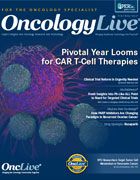Publication
Article
Oncology Live®
Biomarker-Driven Study Aims for Genomic Breakthroughs in AML
Author(s):
A wide-ranging clinical trial is investigating a novel method of determining treatment regimens for acute myeloid leukemia based on genomic testing for each individual patient.
John C. Byrd, MD
A wide-ranging clinical trial is investigating a novel method of determining treatment regimens for acute myeloid leukemia (AML) based on genomic testing for each individual patient. The Beat AML Master Trial will assess up to 10 biomarker-based therapies simultaneously for patients with newly diagnosed AML.
“Rather than taking all AML patients over the age of 60 and treating them the same way, the study takes into account their cytogenetics and their mutational status, and assigns them to a rational therapy based on that,” said John C. Byrd, MD, the D. Warren Brown Chair of Leukemia Research and a distinguished professor of medicine at Ohio State University, and chief medical officer for the Beat AML subdivision of the Leukemia and Lymphoma Society (LLS). LLS is leading the trial.
One of the main goals of the phase Ib/II trial, which is expected to last 2 years, is to find alternative treatments to chemotherapy. “With chemotherapy given with AML, there’s about a 10% mortality at 30 days, and it’s a very rough therapy, which is what we’re trying to get away from,” Byrd said.
Beat AML is open to newly diagnosed patients 60 years and older who have AML, do not have signs of leukostasis requiring urgent therapy, and do not have symptomatic central nervous system involvement (NCT03013998).
Although Beat AML may include as many as 10 experimental arms over the course of its development, it is starting with 4 novel therapies:
• Samalizumab (ALXN6000)—The monoclonal antibody blocks CD200, an immune checkpoint expressed on AML cells. The drug has been tested in trials for chronic lymphocytic leukemia (CLL) but has not yet been evaluated in AML or solid tumors, according to Byrd. Patients who test negative for core binding factors (AML with t[8;21] or inv[16] mutations) or who test negative for the study biomarkers will be eligible for samalizumab in combination with induction therapy, followed by samalizumab maintenance therapy, during the phase I portion of the study. Only core binding factor patients will be enrolled during the phase II portion of the study.
• Enasidenib (AG-221/CC-90007)—This small molecule will be administered to patients with IDH2-mutated AML. Patients will receive up to 5 cycles of enasidenib; those who respond or achieve stable disease can stay on the treatment while those who progress will be given the hypomethylating agent azacitidine.
• Entospletinib (GS-9973)—Patients with MLL translocation will be eligible for entospletinib, a SYK inhibitor that targets B-cell signaling. Patients with the mutation will receive entospletinib for a month; if they respond, they can continue taking the drug while those who do not respond move on to azacitidine.
• BI 836858—Participants with CD33-positive AML will receive BI 836858 plus azacitidine, followed by that combination as maintenance therapy. The drug is a monoclonal antibody with an engineered Fc-gamma receptor.
Overall, an estimated 500 patients are expected to participate in the trial. Each arm will have 25 to 50 patients, with the expectation that participants move from one therapy to another if benefit from the treatment is not apparent. “If we see significant benefit in the 25 [patients], enough to build a body of clinical data that is respectful and the duration of remission is extended, the arm could serve for potential marketing approval,” Byrd said.
In terms of adverse events (AEs), the regimens being studied have shown favorable tolerability, particularly when compared with traditional AML therapy, Byrd said. With immunotherapy drugs, the most commonly observed AEs have been infusion- related or cytopenia, although these events can be hard to differentiate from the symptoms of AML itself. With samalizumab, rash is typically seen but the drug is otherwise well tolerated, Byrd said.
Entospletinib sometimes affects liver tests, so investigators for that arm of the study will monitor patients for liver function impairments, Byrd said. Other AEs include rash and diarrhea, but are low-grade. For enasidenib, the most frequent toxicity is differentiation syndrome, where patients can develop pleural effusions and shortness of breath, and some individuals will experience an AML tumor flare before improving.
A key goal of the study will be to evaluate the logistical process employed. “The endpoint of the master study is to see if we can feasibly do this: to assign patients to receive treatment within 7 calendar days of the samples arriving at the laboratory and to be sure that there’s not any adverse events associated with that,” Byrd said.
Other endpoints include clinical response rate, which consists of complete and partial responses, and toxicity, minimal residual disease status, and quality-of-life impact. For regimens that have shown higher response rates than traditional therapy, the endpoint would be overall survival at 1 or 3 years that matches what is achieved with chemotherapy, Byrd explained. “The study is designed to adapt quickly to results we see, so a lot of the studies will be done in relatively real time so that we can learn, and we are very adaptive to the knowledge we store,” he said.
If this novel strategy works, it could change the standard of care in that patients with AML would receive therapy based on genomic profiling rather than undergo the same treatments, said Byrd. LLS contends that the standard of care for patients with AML has not changed in 40 years.
The Beat AML trial is launching initially at 5 leading cancer centers: The Ohio State University Comprehensive Cancer Center, Memorial Sloan Kettering Cancer Center, OHSU Knight Cancer Institute, Dana-Farber Cancer Institute, and Massachusetts General Hospital Cancer Center. Pharmaceutical developers participating in the trial thus far are Alexion (samalizumab), Boehringer Ingelheim (BI 836858), Celgene (entospletinib), and Gilead Sciences (enasidenib). Foundation Medicine and Genoptix are providing genomic assays.










